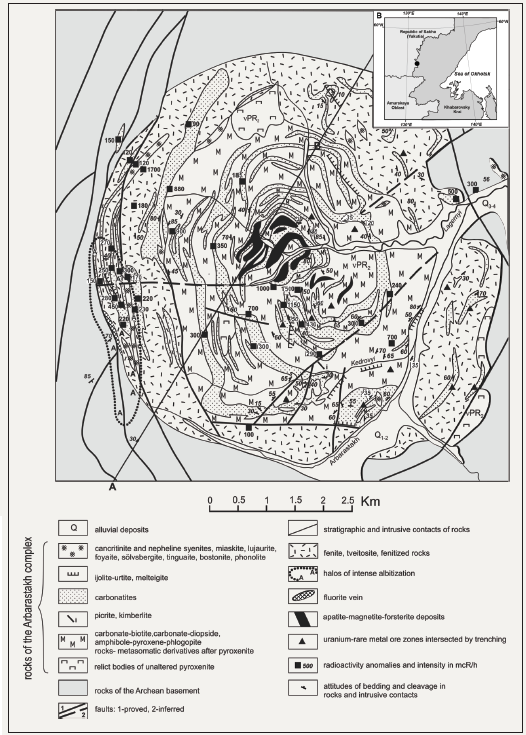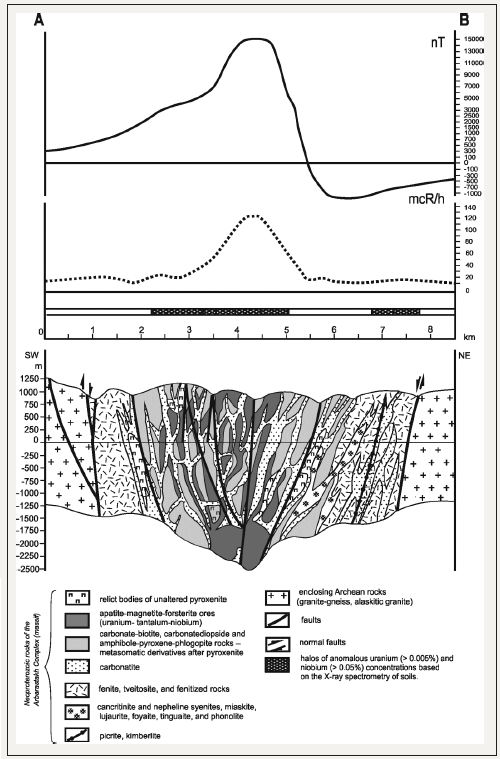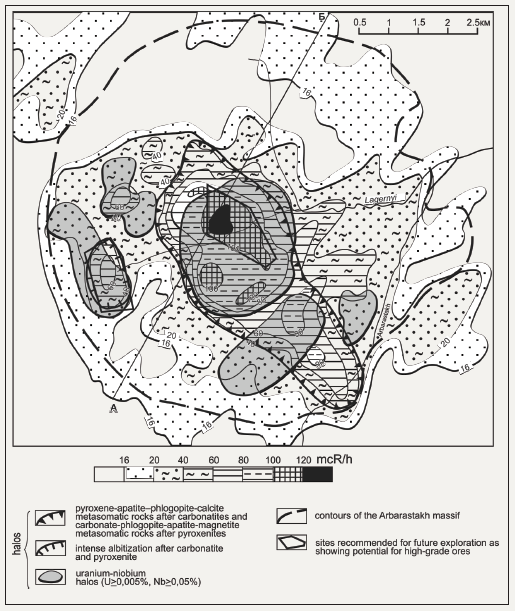- Submissions

Full Text
Archaeology & Anthropology:Open Access
Geology and Metallogeny of the Arbarastakh Alkaline-Ultrabasic Massif (SE Siberian Platform)
Goroshko MV*, Guryanov VA, Didenko AN and Gilmanova GZ
Yu A Kosygin Institute of Tectonics and Geophysics, Russian Academy of Sciences, Russia
*Corresponding author: Didenko AN, Yu A Kosygin Institute of Tectonics and Geophysics, Far Eastern Branch, Russian Academy of Sciences, Kim Yu Chen St., Khabarovsk, Russia
Submission: July 02, 2018;Published: September 20, 2018

ISSN: 2577-1949 Volume3 Issue1
Abstract
This paper presents the analysis of data on patterns observed in the localization of high-grade uranium-tantalum-niobium ores in the Arbarastakh massif of alkaline ultrabasic rocks of Proterozoic age. Processes are characterized that have different effects on the parameters of uranium-tantalumniobium mineralization, as well as their magnetic and radiometric signatures. Uranium-rare metal ores are concentrated in metasomatic rocks of the post-magmatic stage in the massif development, whose formation is related to mantle-derived fluids with iron, phosphorus, sodium, uranium, niobium, tantalum, zirconium, and rare earth elements in the appreciably mobile state. Two types of metasomatic processes can be recognized:
A. Zones of albitization and high radioactivity in the north-south trending fault in the western exo-contact zone of the massif hosting high-grade and large-scale uranium-tantalum-niobium mineralization.
B. Fields of kamaphorites hosting high-grade mineralization controlled by local magnetic and radioactive anomalies of high amplitude in the NWtrending zone at the centre of the intrusion.
Keywords: Siberian platform; Arbarastakh massif; Metallogeny; Fields of high radioactivity and magnetization; Carbonatites; Kamaphorites; Albitites; U-Ta-Nb ores
Introduction
Nine Proterozoic-age deposits of uranium-tantalum-niobium ores are known in the south-eastern part of the Siberian Platform. Despite appreciable metal resources, mining of these ores is not economically viable considering run-of-mine grades, remoteness of the area and poor infrastructure. Our objective was to choose from these nine deposits the one that would combine high-grade ores and large tonnage reserves which would be economically and technically feasible to extract. Based on this, the Arbarastakh intrusion of alkaline ultrabasic rocks most intensely studied by Production Geological Association “Taezhgeologiya” in the 1990s using geological and geophysical methods appears to be particularly promising [1-3]. Uranium-tantalum-niobium ores including high-grade ore zones (up to 6% Nb and 0.6% U and over 0.1% Ta) were found within the intrusion. The aim of this paper is to develop criteria governing the concentration of such ores using the available data, as well as to identify areas as most likely to have uranium, tantalum and niobium potential for follow-up exploration. Geophysical, geological, mineralogical, and geochemical data, data on digital elevation model analysis using satellite imagery, and other data were reviewed in the course of the study.
Geology and Mineralization of the Arbarastakh Intrusion
The Arbarastakh massif of alkaline ultrabasic rocks and carbonatites occurs in the Idyum Khaikan block of Archean metamorphic rocks of the Aldan-Stanovoy Shield (Figure 1). In the 1950s, specialists from Aerogeologiya Production Association, Yakutsk Production Geological Association, Institute of Geology of Ore Deposits, Petrography, Mineralogy and Geochemistry (IGEM), Institute of Mineralogy, Geochemistry and Crystal Chemistry of Rare Elements (IMGRE) and AP Karpinsky Russian Geological Research Institute (VSEGEI) were engaged in exploration activities and special-subject studies in some areas of the massif. In the 1990s, Production Geological Association “Taezhgeologiya” performed Airborne Gamma-ray Spectrometry (AGS) surveying of the Arbarastakh massif (scale 1:50000) and ground reconnaissance for radioactive minerals, which resulted in location of about twenty zones hosting uranium-rare metal mineralisation, including highgrade ore zones. Of interest are the results obtained in 2000, when accumulations of high-grade uranium-tantalum-niobium ores were located for the first time in zones of albitization after carbonatites and gneisses hosting them.
Figure 1:Schematic geological map of the Arbarastakh massif.

Archean rocks enclosing the massif are granitized metamorphic rocks of the marble-schist two-pyroxene rock association. The Arbarastakh massif covering an approximately 38-km2 area is formed by rocks of three magmatic phases:
1. Alkaline clinopyroxenite.
2. Carbonatite-rock series.
3. Dykes of melteigite, ijolite, alkaline syenite, solvsbergite, tinguaite, pulaskite with trachytoid texture, foyaite, and cancrinite lujavrite.
The massif has a concentrically zoned structure in plan (Figure 1). The core appears as an elliptically shaped stock-like body of clinopyroxenite (6.7km by 5.3km) metasomatized to phlogopiteamphibole, phlogopite and vermiculite [2]. Enclosing fenites and fenitized gneisses and schists occurring within a continuous ring zone some 0.5-1.2km wide and partially overlying the adjacent ultramafic rocks, are located between alkaline clinopyroxenites and unaltered rocks of Archean age. Fenites correspond to syenites in composition and contain albite, microcline, aegerine, arfvedsonite, riebeckite, rarely nepheline and cancrinite [2]. The second phase of magmatism is represented by the carbonatite suite of rocks. The carbonatite is developed along systems of variously oriented conical, cylindrical, and diagonal fractures both in the clinopyroxenites, where they account for about 20% of the area of the massif, and in the exo-contact zone of the massif. Common are carbonatite bodies that are half-ring, crescent or arcuate in shape and variously shaped stock works and vein zones. Deposits vary in size widely, with thicknesses reaching hundreds of meters, and extend for 5 to 6km along strike. Regardless of their proximity to the centre of the massif, carbonatite bodies dip inward at 60-80°, occasionally at 20-30°.
Clinopyroxenites and metasomatized pyroxenites are intruded by dykes of melteigite, ijolite, alkaline syenite, sölvsbergite, tinguaite, trachytoid pulaskite, foyaite, and cancrinite lujaurite of the third phase, often with sulphide and fluorite mineralisation and high yttrium concentrations (Figure 1). Veined bodies of alkaline picrite occur in the core of the massif and its south-eastern parts. High-amplitude magnetic and radioactivity anomalies were detected as a result of the integrated airborne geophysical survey over the massif at a scale of 1:50000 (Figure 2 & 3). Increments of the magnetic field over the massif are between 4000 and 7000nT, the maximum being 15000nT, and radioactivity is in the range of 19 to 130 micro roentgens per hour (mcR/h). Radioactivity is mainly associated with uranium, occasionally with a mixture of radioactive minerals. The radioactivity map shows a 2.0x5.2km block in the central part of the massif along the 40mcR/h isoline, which extends northwest and stands out as having airborne radioactivity values up to 100-130mcR/h (radioactivity values on the ground are 1500mcR/h and higher). Niobium, tantalum and uranium concentrations are directly proportional to the intensity of the magnetic field and radioactivity (Figure 3).
Figure 2:Schematic geologic-geophysical cross-section through the Arbarastakh intrusion along the line A-B [1,2].

As a result of three-dimensional modeling using magnetic and gravimetric data, the Arbarastakh pyroxenite core appears as a near-vertical stock slightly tilted to the south-west whose diameter increases from 3.5 to 4.8 km to a depth of 2km from the surface and then decreases with depth to 3.7km. In the upper part of the massif, local magnetic anomalies of high amplitude indicate the presence of rare metal apatite magnetite mineralisation, which according to modelling results approximate to the tabular ore bodies tilted at 45-700. The morphology of the anomalous magnetic field shows evidence of the concentrically zoned structure of the massif. To determine the age of the uranium-tantalum-niobium mineralisation U-Pb and Th-Pb isochrones were employed, which yielded 761±18Ma and 797±51Ma, respectively (Figure 3). The uranium-tantalum-niobium ore is hosted by post-magmatic metasomatic rocks varying in mode of occurrence. Two settings favourable for the concentration of uranium-tantalum-niobium ores are identified:
Figure 3:Schematic map of geochemical halos and airborne radiometric field of the Arbarastakh massif.

1. The NW-extending block in the central part of the massif.
2. The area of radioactivity halo with the intensity in the range 40-60mcR/h (radioactivity values on the ground are up to 300mcR/h), which is 0.5±1.0km in size and confined to the NS-striking fault in the western end contact zone of the massif.
Within the north-western block, pyroxenites and carbonatites underwent pervasive cataclasis and shearing followed by metasomatism caused by mantle fluids transporting mobile iron, phosphorus, uranium, thorium, niobium, tantalum, zirconium, and rare earth elements of the cerium group with the resulting formation of ore-bearing metasomatic pyroxene-phlogopite-calcite rocks after carbonatites and metasomatic carbonate-phlogopitemagnetite rocks after pyroxenites. Metasomatic processes were most intense in the upper reaches of the Lagernyi Creek, where altered rocks of the central part of the metasomatic column were mapped and over which, according to the AGS survey data, radioactive highs were recorded. They occur as rare metal-apatitemagnetite ores with forsterite that form tabular ore bodies of different orientation and vertical ore bodies (“chimneys”) as thick as 50-70m. Calculations of the dip and strike of anomalous bodies indicate centroclinal bedding of apatite-magnetite-forsterite ore deposits (Figure 2).
The ore-bearing metasomatic rocks of the block host an area with radioactivity up to 1500mcR/h. The intersected higher-grade ore lenses and stocks assayed 1.24-4.39% niobium, 0.09-0.26% tantalum, and up to 0.6% uranium over 2.1metres. Rare earth and rare metal minerals are hatchettolite, betafite, baddeleyite, perovskite, dysanalyte, zircon, zirconolite, bastnaesite, and other rare minerals. No other high-amplitude anomalies were intersected by trenching. The occurrence of such high-grade ores suggests that deposits of high-grade ore remain to be found. Anomalous uranium, tantalum and niobium values are confined to the zones of intensely albitized rocks at the western end contact of the Arbarastakh massif. Relict minerals (carbonate, phlogopite) show clear corrosive relations with the albite of a later stage.
Relict minerals (carbonate, phlogopite) and late-stage albite occur in relationships strongly suggesting corrosion. The intensity of albitization varies widely and carbonate is often almost completely replaced by albite. Depending on the intensity of albitization, the rock has the following composition: 90-25% phlogopite, 2-45% carbonate, 20-65% albite, 0.2-25% microcline, 0-5% apatite, 3-10% hatchettolite, up to 5% zircon, 0.1% fluorite, and 0.1% pyrite. High concentrations of uranium (up to 0.28%), niobium (up to 2.5%), and tantalum (up to 0.12%) are characteristic of the ores in which albitite accounts for over 35%. According to the factor analysis data, there is good reason to believe that in addition to uranium-bearing hatchettolite there occur clearly uranium minerals. This is also supported by a relatively weak correlation between uranium and niobium. A distinct correlation is established between concentrations of uranium and niobium and radioactivity and magnetisation of rocks as a result of iron and radioactive elements re-mobilisation into the ore zones. In addition to zirconium and rare earth elements, one can consider strontium, titanium and copper as associated ore components.
Conclusion
The Arbarastakh intrusion of alkaline-ultrabasic rocks formed in the hypo- to meso-abyssal settings. It appears as a subvertical, pipe-like body of 38km2 in area, which has been traced by geophysical methods to a depth of at least 10km. The NW-extending block is located in the central part of the massif, which hosts highgrade uranium-tantalum-niobium ores. The relation is established between concentrations of ore elements and intensity of magnetic and radioactive fields, and intensity of the latter is correlated with the grade of hydrothermal metasomatism of wall rocks. Uranium tantalum niobium mineral isation hosted within albitites overlying the rocks both of the massif and the Archean basement, occur in the NS-striking tectonic zone of the western near-contact part of the Arbarastakh massif. Mineral contents in the ores are higher than in the high-grade ores of the central part. The occurrence of high-grade ores in the zones of albitization enhances the potential of the Arbarastakh intrusion to host economic uranium-tantalumniobium mineralisation. The lack of magnetic anomalies in the zones of albitization with radioactivity highs may suggest that mineralisation in the massif developed in several stages. Resources are assessed at 215000t U, 8000000t Nb, and 140000t Ta [2]. Resources of the Arbarastakh massif estimated by the above major components are about ten times larger than minimum resources for large deposits and are classified as extra-large. In addition, magnetite and apatite can also be extracted as a by-product.
The Arbarastakh deposit of uranium-tantalum-niobium ores is located in an area with a favorable infrastructure. About 50km south of it there is the railway station Elga on the Ulak-Elga branch line which connects Russia’s largest coalfield Toko to the Baikal- Amur Mainline.
Acknowledgement
The authors express their sincere gratitude to the anonymous reviewers. The manuscript benefited from their helpful comments and suggestions. Tatyana Koryakina and Olga Men’shikova are thanked for assistance with the manuscript readability and graphics. This study was carried out as part of the governmental assignment to the Institute of Tectonics and Geophysics and received financial support from the Khabarovsky Krai Government (project “Rare Earth Mineralisation…”), deposits in the Far East of Russia.
References
- Goroshko MV, Malyshev Yu F, Kirillov V Ye (2006) Uranium metallogeny of the Russia far east. Nauka, Moscow, Russia.
- Goroshko MV, Guryanov VA (2004) Uranium-rare metal mineralisation in alkaline-ultrabasic masiffs of the south-eastern Siberian Platform. Tikhookeanskaya Geologiya 2: 76-91.
- Shnaider AA, Malyshev Yu F, Goroshko MV, Romanovsky NP (2011) Multimineral mineralisation of large-tonnage hard-rock deposits in the far East of Russia. Geologiya Rudnykh Mestorozhdenii 53(2): 158-174.
© 2018 Goroshko MV. This is an open access article distributed under the terms of the Creative Commons Attribution License , which permits unrestricted use, distribution, and build upon your work non-commercially.
 a Creative Commons Attribution 4.0 International License. Based on a work at www.crimsonpublishers.com.
Best viewed in
a Creative Commons Attribution 4.0 International License. Based on a work at www.crimsonpublishers.com.
Best viewed in 







.jpg)






























 Editorial Board Registrations
Editorial Board Registrations Submit your Article
Submit your Article Refer a Friend
Refer a Friend Advertise With Us
Advertise With Us
.jpg)






.jpg)














.bmp)
.jpg)
.png)
.jpg)










.jpg)






.png)

.png)



.png)






